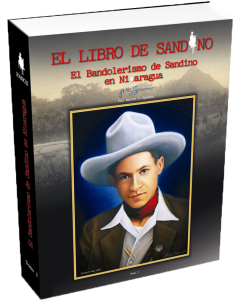
Menú
Menú
Crítica al Libro de Sandino
Español: Una valiosa contribución al canon Sandino, profusamente ilustrado con fotografías, mapas y documentos, muchos de ellos nunca antes publicados hasta ahora, el homenaje de Walter C. Sandino a la vida y la lucha de su abuelo no es sólo un volumen excepcionalmente hermoso y maravillosamente producida. También ofrece rigor académico meticuloso en el tratamiento de un sujeto frecuentemente mal entendido y mitificado. Gracias a su esmerada atención al detalle y exactitud, este magnífico libro, sin duda, la prueba del tiempo para convertirse en la historia documental de mayor autoridad única en la impresión sobre la vida del famoso héroe nacional de Nicaragua y su épica lucha por la dignidad nacional y la soberanía de su patria, hasta mediados de 1929. Los especialistas de Sandino y los lectores en general sólo pueden esperar en ansiosa espera para el segundo volumen, que llevará la historia hasta el final de la guerra y sus secuelas. En conjunto, estos dos volúmenes se representan uno de los eventos editoriales más importantes en Nicaragua desde hace muchos años, destinado a convertirse en clásicos en el campo. En resumen, este volumen hermoso y autoritativo merita un lugar destacado en la plataforma de todos los interesados en la lucha de Nicaragua por la justicia, la libertad y la soberanía en la época moderna.
English: An invaluable contribution to the Sandino canon, lavishly illustrated with photographs, maps, and documents, many never before published before now, Walter C. Sandino’s homage to the life and struggle of his grandfather is not only an exceptionally handsome and beautifully produced volume. It also offers meticulous academic rigor in treating an often misunderstood and mythologized subject. With its painstaking attention to detail and accuracy, this magnificent book will doubtless stand the test of time to become the single most authoritative documentary history in print on the life of the famed Nicaraguan national hero and his epic struggle for the national dignity and sovereignty of his homeland, up to mid-1929. Sandino specialists and general readers alike can only wait in eager anticipation for the second volume, which will carry the story through to the end of the war and its aftermath. Together these two volumes will represent one of the most important publishing events in Nicaragua in many years, destined to become classics in the field. In short, this beautiful and authoritative volume merits a prominent place on the shelf of everyone interested in Nicaragua’s struggle for justice, freedom, and sovereignty in the modern .
English: An invaluable contribution to the Sandino canon, lavishly illustrated with photographs, maps, and documents, many never before published before now, Walter C. Sandino’s homage to the life and struggle of his grandfather is not only an exceptionally handsome and beautifully produced volume. It also offers meticulous academic rigor in treating an often misunderstood and mythologized subject. With its painstaking attention to detail and accuracy, this magnificent book will doubtless stand the test of time to become the single most authoritative documentary history in print on the life of the famed Nicaraguan national hero and his epic struggle for the national dignity and sovereignty of his homeland, up to mid-1929. Sandino specialists and general readers alike can only wait in eager anticipation for the second volume, which will carry the story through to the end of the war and its aftermath. Together these two volumes will represent one of the most important publishing events in Nicaragua in many years, destined to become classics in the field. In short, this beautiful and authoritative volume merits a prominent place on the shelf of everyone interested in Nicaragua’s struggle for justice, freedom, and sovereignty in the modern .

